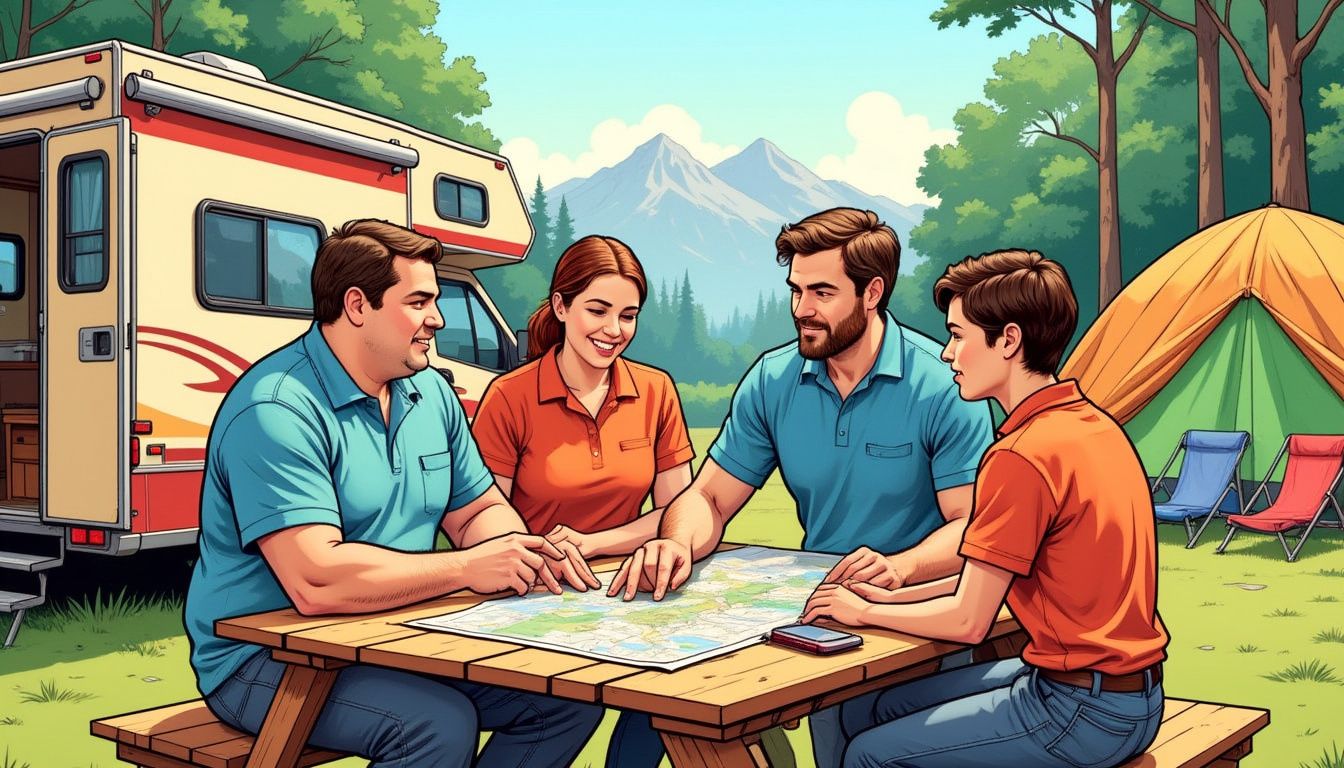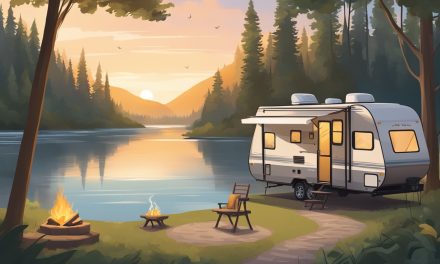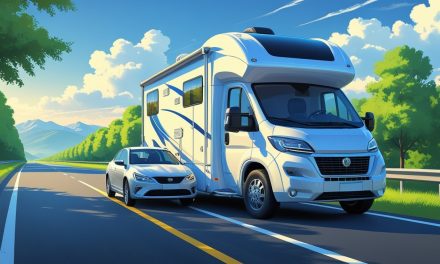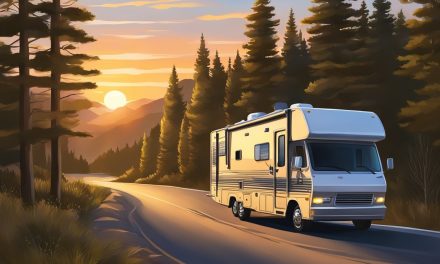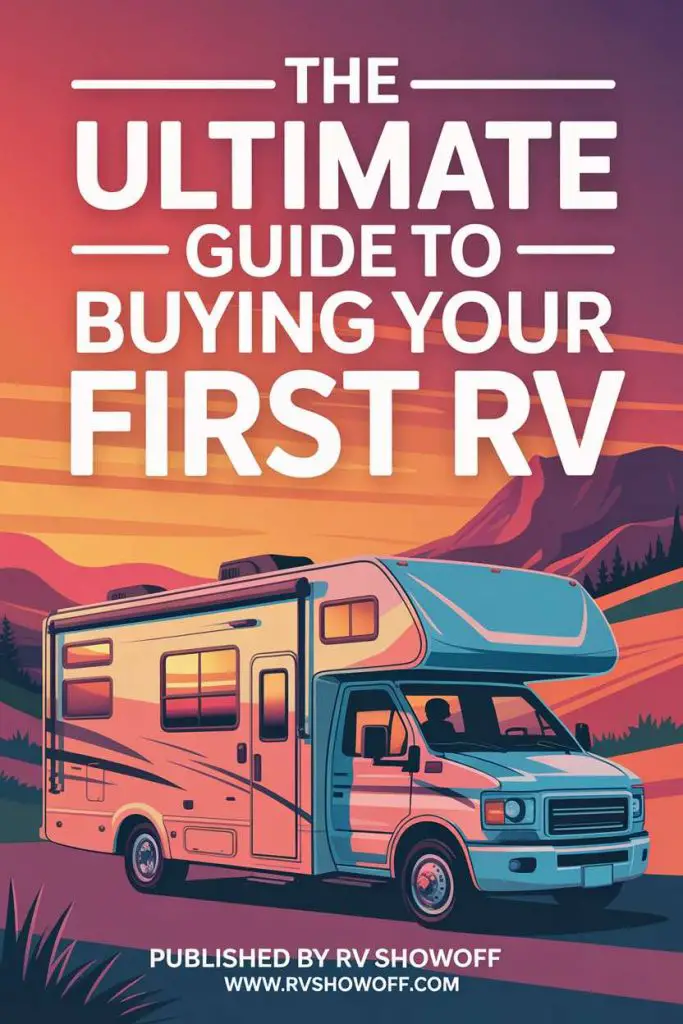Would you like to save this article?
Own an RV? Beware Glacier National Park! Planning a trip there comes with many challenges, like road closures and tight campgrounds. This guide will help you prepare for permits, wildlife risks, and rough weather.
Keep reading to explore how to stay safe and make the most of your adventure!
Key Takeaways
- Plan for permits early. Glacier requires entry and route-specific permits, like the Going-to-the-Sun Road permit. Buy them online as they sell out quickly in peak seasons.
- Stay updated on road closures and wildlife alerts. Roads often close due to snow, grizzly bear activity, or construction. Check park updates daily to avoid delays.
- Wildfire risks are high in summer. Smoke can block views and reduce air quality. Be ready for sudden evacuations and carry bear spray during hikes.
- Campgrounds are small and fill fast. Many only fit vehicles under 40 feet. Arrive early or book ahead to secure a spot with enough space for your RV.
- Be flexible with plans. Weather changes fast here, causing detours or canceled hikes. Pack for cold nights even in summer and prepare backup routes before traveling.
Challenges of RV Trip Planning to Glacier National Park
Planning an RV trip here isn’t a walk in the park, literally or figuratively. Tight spaces, sudden changes, and wildcards like weather can shake up even the best plans.
Closed roads
Road closures can catch you off guard. Glacier National Park often shuts roads due to snowstorms, avalanches, or grizzly bears wandering too close. Construction projects in busy seasons also block paths, causing delays.
For example, Going-to-the-Sun Road frequently faces weather-related closures during late fall and early spring.
Keep an eye on alerts from park rangers. Animal activity like black bears or mountain lions near roads may lead to sudden shutdowns for safety. Always check conditions before heading out with your motorhome or airstream.
This helps avoid backtracking and wasting time on detours in unpredictable weather or wildlife situations.
Smoke evacuations
Wildfires can throw a wrench in your Glacier National Park plans. Smoke from these fires often clouds the skies, making views less clear. Poor air quality can also make outdoor activities tough, especially hikes or backcountry trips.
In some cases, smoke gets so bad that park officials order evacuations for safety.
You might face sudden changes to routes and schedules due to wildfire risks. Grizzly bears and cougars may come closer to areas with people during such times as well. Always have bear spray ready when exploring.
Before heading out, check forums or official updates about conditions inside Glacier Park.
Small campgrounds
Finding a spot for your motorhome in Glacier National Park can feel like squeezing into skinny jeans after the holidays. Many campgrounds are small and better suited for campers or airstreams under 40 feet.
If your RV is larger, you’ll struggle to park it; some sites won’t even allow big rigs past the entrance.
Some locations have pit toilets and little else, so prep ahead. With space at a premium, arriving early helps snagging that elusive campsite. Watch for signs warning about grizzly bears too.
They roam here often, and proper food storage isn’t just smart—it’s required!
Extensive permit system
You need several permits to explore Glacier National Park in your motorhome. A ticket is required just to enter the park during peak months. Another permit is necessary for Going-to-the-Sun Road, one of the most popular routes with breathtaking scenery.
Get these permits online through the National Park’s website before your trip. They sell out fast, especially in summer! Keep an eye on dates and plan ahead. This system might seem complex, but it helps protect the park’s natural beauty and wildlife, like grizzly bears.
Planning properly makes your journey smoother and lets you focus on enjoying the adventure.
Ready to tackle road closures or find cozy campgrounds? Let’s get into it!
Personal Experience of RV Owners
You’ll smile, laugh, and maybe groan hearing how RV trips to Glacier have turned from simple cruises into full-blown logistical puzzles over the years.
Visits across three decades
Teenage years meant tent camping. Glacier National Park felt wild and untouched then. You could snag a spot without much fuss. No permits, no long waits, just simple exploring.
By 2017, the trip looked different. A 30ft Airstream came along, but challenges piled on too. Roads closed unexpectedly; smoke from fires chased you out. Campgrounds felt small for larger RVs like motorhomes or travel trailers.
Planning now feels even trickier for the upcoming 2024 visit with a 25ft motorhome in tow!
Increasing complexity of visiting the park
Over the years, visiting Glacier National Park has gotten harder. Roads often close due to snow or repairs. Fires can force sudden smoke evacuations in summer months. Campgrounds feel tighter as RV sizes grow, leaving less space for parking big rigs.
The park now requires multiple permits for different areas and activities. This includes access to spots like Going-to-the-Sun Road during peak times. It’s easy to miss a step if you’re not prepared, adding stress to your trip planning.
Must-Do in Glacier National Park
Drive the famous Going-to-the-Sun Road, but pack patience—it’s a narrow beast that demands focus and maybe a little courage.
Going-to-the-Sun Road
Going-to-the-Sun Road is a showstopper, but it has strict rules. RVs longer than 21 feet or wider than 8 feet aren’t allowed. The road’s hairpin turns and narrow lanes make it too risky for large vehicles.
Landslides and avalanches can also cause sudden closures. Smoke from wildfires may block views during summer months.
If your RV doesn’t meet the size limit, consider taking a shuttle bus to enjoy the stunning scenery without stress. Planning extra stops? Check for parking spaces early, as spots fill up quickly near Lake McDonald and Logan Pass.
Staying informed will make exploring Glacier National Park smoother despite challenges like permits or campground limits!
Challenges and alternatives
Many RVs exceed the 21-foot length limit on Going-to-the-Sun Road. Long bed duallies and other bigger rigs simply cannot enter. You can bring a smaller vehicle, rent one nearby, or hop onto the Red Bus Tours.
The free National Park buses are also great choices.
Wildfire smoke can force evacuations fast during summer. Always check air quality before heading out. Road closures due to snow or repair happen often too. Stay prepared with backup routes in mind and keep avalanche safety gear if traveling in colder months.
Next, let’s explore permits and campground tips for your trip!
Navigating Permits and Campgrounds
Getting permits and finding a good campsite can feel like solving a tricky puzzle, but it’s all part of the adventure.
Obtaining multiple permits
You need permits to explore Glacier National Park. One is for general entry, and another is required to drive Going-to-the-Sun Road. Without them, your plans may hit a wall fast. Buy these on the park’s website early.
They sell out quickly during busy seasons.
Set reminders so you don’t miss the right dates. Permits have specific time slots too; it’s not a one-size-fits-all deal. Plan ahead while browsing campsites that work for RVs, leading into finding suitable campgrounds next!
Finding suitable campgrounds
Some campgrounds at Glacier National Park can feel tight for big RVs. Many spots are under 40 feet, which makes parking tricky. Apgar Campground is one of the few with more room but fills fast in summer.
Smoke from wildfires might force campground closures without warning. Check updates often and have a backup plan ready. Smaller sites mean fewer options, so arrive early or book ahead where possible.
Checking for road closures
Roads in Glacier National Park can close without much warning. Weather, animal activity like grizzly bears crossing, or construction often shut routes. Keep an eye on the park’s website for updates before driving out.
Going-to-the-Sun Road is a top attraction but closes often due to snow or maintenance.
Have a backup plan ready if your chosen path isn’t open. Late spring and early fall tend to bring surprise closures, so flexibility is key. Be aware that delays may also happen during avalanche control efforts or fire smoke evacuations nearby.
Always check the latest alerts and map changes before hitting the road!
Encouragement to Visit Glacier National Park
Pack your sense of wonder; Glacier feels like stepping into a postcard. Every corner promises an adventure you won’t forget, so keep your boots ready!
Breathtaking views
Lake McDonald stretches out before you, reflecting the towering peaks like a giant mirror. Its clear waters shimmer in the sunlight, offering views that make your heart skip. Hidden Lake feels untouched by time, surrounded by rugged cliffs and wildflowers bursting with color.
Every angle looks straight out of a postcard.
From Going-to-the-Sun Road, you’ll catch sweeping vistas of jagged mountains and deep valleys below. The air carries a bite as snow patches cling to rocky faces even in summer. Keep an eye out for grizzly bears wandering near tree lines or grazing elk far in the distance.
The sights are pure magic at every turn!
Adventurous hikes
Highline Trail offers thrill and beauty. You’ll walk along cliff edges with sweeping views of the park. Grizzly bears roam nearby, so carry non-lethal bear spray. Wear sturdy boots for its rugged paths and steep drops.
Iceberg Lake is another gem, surrounded by icy waters and snowy peaks. It’s a 10-mile round trip but worth every step.
Pack avalanche rescue equipment if hiking in colder months. Sudden weather changes can leave you exposed to harsh conditions. Prey animals may cross your path, adding excitement but also caution to your trek.
Stay vigilant for ticks carrying Rocky Mountain spotted fever on less-traveled routes too!
Preparation and flexibility
Planning a trip to Glacier National Park takes effort. Roads might close without warning due to snow or wildfires. Smoke from fires can make you leave sooner than planned. Small campgrounds fill up fast, especially during summer months.
You need to stay flexible while preparing for this adventure. Pack with changing weather in mind; temperatures can swing wildly between day and night. Check park alerts daily for road closures and trail updates, including the Going-to-the-Sun Road status.
Have backup plans for hikes or campsites if your first choices don’t work out. The efforts are worth it once you’re surrounded by breathtaking views and fresh mountain air!
Conclusion
Glacier National Park is worth the effort. The views, wildlife, and adventures will blow your mind. Plan well, stay flexible, and enjoy every moment. Even with challenges like permits or closed roads, it’s an RV trip you won’t regret.
Pack smart, stay safe, and hit the road!
FAQs
1. What should I know about driving an RV on Going-to-the-Sun Road?
Driving an RV on Going-to-the-Sun Road can be tricky. The road is narrow with sharp turns and steep drop-offs. Check the size restrictions before you go, as large RVs may not fit safely.
2. How can I stay safe from grizzly bears in Glacier National Park?
Grizzly bears are common in Glacier National Park. Store food properly to avoid attracting them, and carry bear spray when hiking or camping nearby.
3. What steps should I take to secure my hitches during the trip?
Check your hitches often, especially after bumpy roads or long drives. Loose connections can cause accidents, so double-check before heading out each day.
4. How do I protect myself from weather exposure while exploring Glacier National Park?
Weather changes quickly at Glacier National Park. Bring layers for warmth and rain protection, and keep sunscreen handy for high-altitude sun exposure.


